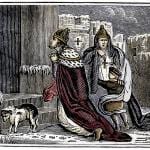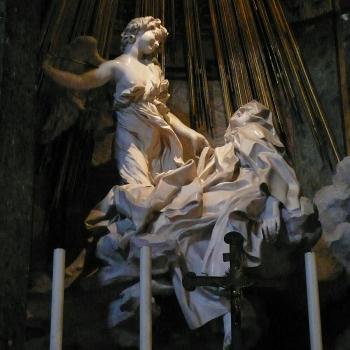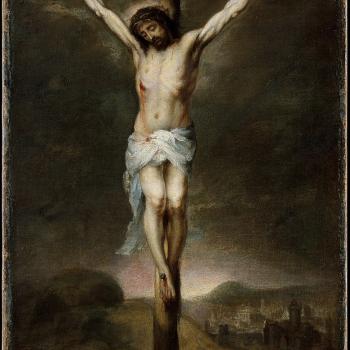If you are up-front about your experience of either addiction, or let’s say marginalized sexuality, and you spend a lot of time with Christians from Orthodox or Eastern Catholic churches, eventually somebody will tell you to pray to Mary of Egypt. This is probably a good idea (look at this lady! Do you want to get in her way? Neither does sin) and I do it every night; and yet I am pretty ambivalent about her story, and want to suggest a couple cautionary notes about its contemporary deployment.
# A of all, what was Mary’s deal? This page gives the story as I hear it most often:
She began her life as a young woman who followed the passions of the body, running away from her parents at age twelve for Alexandria. There she lived as a harlot for seventeen years, refusing money from the men that she copulated with, instead living by begging and spinning flax.
One day, however, she met a group of young men heading toward the sea to sail to Jerusalem for the veneration of the Holy Cross. Mary went along for the ride, seducing the men as they traveled for the fun of it. But when the group reached Jerusalem and actually went towards the church, Mary was prohibited from entering by an unseen force. After three such attempts, she remained outside on the church patio, where she looked up and saw an icon of the Theotokos. She began to weep and prayed with all her might that the Theotokos might allow her to see the True Cross; afterwards, she promised, she would renounce her worldly desires and go wherever the Theotokos may lead her.
So first of all I will make the extremely obvious point that if you tell gay people we should have some special connection to Mary of Egypt it sounds like you’re saying being gay is inherently a condition of excessive sexuality. This is a traditional position in the Church and it fosters, in my opinion, the characteristic Christian mistake of “reading” homosexuality as a problem in the sex drive, where the remedy is heterosexuality, instead of a problem in one’s same-sex longings and desires, where the remedy is living one’s same-sex loves chastely. But beyond any theological problems, I am not convinced that a gay woman who has had (for example) two sexual partners in her life, both of which were within long-term relationships, is really gonna relate all that well to Mary of Egypt simply because she’s gay.
Sarah at A Queer Calling put this whole situation so sharply in her lovely post about choosing St. Photini as her patroness:
After hearing the names of these two saints repeated one after the other for weeks, I finally asked someone, “Why do you think so many people are advising that I take either St. Mary of Egypt or St. Mary Magdalene as my patroness?”
Seemingly puzzled by my lack of insight, he replied, “Because they’re both women who repented of serious sin.”
Having spent years reading and learning about the lives of the saints, I pressed further, “That’s true for many holy men and women the Church recognizes. What’s so special about St. Mary of Egypt and St. Mary Magdalene in that regard?”
He took a moment to stare at his shoes. Then, in a muted tone he spoke, “They repented and overcame their passions. They asked God to rid them of lustful desires…something like what you’re doing with celibacy.”
I walked away from this interaction without saying much more.
# Since Mary didn’t get that money, she was not a sex worker. Was she a sex addict?
One of the definitions of addiction which I’ve found most illuminating in my own recovery is, persistence in a compulsive behavior in spite of negative consequences. Addiction is that feeling of being desperate not to drink, as you walk the familiar route to the liquor store. Addiction is drinking even when it isn’t fun anymore–when the liquor which used to make you more social now keeps you isolated, when what used to make you overcome your fears now keeps you trapped and terrified, and you go back to it anyway, getting no reward, hoping this time will be different, this time it will work again, and it keeps not working.
As far as the hagiographers are concerned, Mary suffered no negative consequences from her sexual appetites right up until that day she tried to venerate the Cross. Her hagiography may be punctuated with troubling silences (why do girls run away at age 12?) but at least from the legend that has been handed on, she enjoyed the Hell out of her sins. And practically the instant sin kept her from something she wanted, she stopped!
The characteristic experience of addiction, the source of all its demoralization and despair, doesn’t seem to be an experience Mary had.
# Which brings us to that moment when an “unseen force” keeps her from entering the church. You know what unseen force usually keeps sinful people from coming into church? The Devil.
Probably the worst period of my alcoholism was when I stopped going to Confession. Shame and hopelessness almost kept me from church entirely. What kept me going was a combination of numb habit and the knowledge that missing Sunday Mass, at least, was a mortal sin. (You’ve gotta love Catholics–swilling a handle of bottom-shelf bourbon, frantically Googling “is epiphany a holy day of obligation”….) And I can’t tell you how grateful I am that God got me over that threshold, awful hungover evening after evening.
I love the 12 Steps, you guys know this about me, but all my memories of meetings are about sitting in a room while people tell their stories, thinking, All these people are better than me.
It’s too easy to tell Mary’s story in a way that suggests we are right when we think we’re too soiled and selfish, too damaged and disgusting to come to Christ.
# And yet I do pray to her all the time; I love her. You guys know that I’m reticent on the subject of my own *~*struggles with chastity*~* and boy howdy, I’m not planning to change that, but I do in fact need and resort to the patroness of the sexually-chaotic. She’s the patroness of sleazoids; and so talking about how much you love her offers a salutary humiliation. I like that we have a saint where all you have to do is say that you have a special devotion to her and people are all like, “…Ohhhhhh.”
# There are deeper readings of her story, in which it’s a story about hunger. That insatiable hunger for sex or for men isn’t the opposite of her life abandoned to God in the desert. It’s the foreshadowing of her desert life. Only God could meet that giant hunger. Her capacity for sin was her capacity for love–a desire so strong that once it found its proper object, it could only become spectacular holiness.
Or maybe her hunger was always a fear that she could not be okay on her own. In the desert God tells her, You have all you need. This fear of being without the shelter of others–without their approval, without their physical presence, (frankly) without their health insurance–is something I think a lot of people nowadays can relate to. In the desert God tells Mary, You’ll never spend another night without a Lover.
# The troparion honoring Mary in the Orthodox Church begins with a line which can act as antidote, I hope, to any readings of Mary’s story which would turn hagiography into self-harm: “The image of God was truly preserved in you, O mother,/For you took up the Cross and followed Christ.” But of course she bore the image of God even before she took up her cross; and here we find our hope.
The image of God is preserved in you. God has prepared salvation for you, even when you turn away from it because you don’t deserve it or can’t imagine it. Even now, the image of God is preserved in you.
Picture of an icon of Mary of Egypt via Wikimedia Commons.












